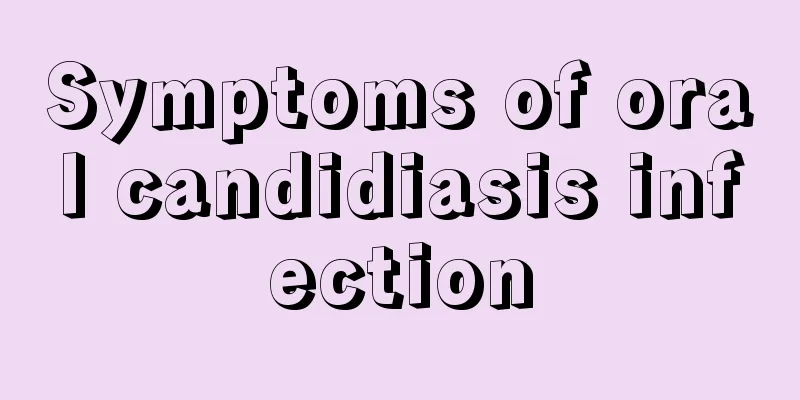Symptoms of oral candidiasis infection

|
Oral candidal infection is a common oral disease. Patients with oral candidiasis will experience inflammation and infection in the mouth, and severe cases may affect their daily activities. If you have oral candidiasis, you should use anti-inflammatory drugs to reduce inflammation in your mouth as soon as possible, and you should also pay attention to avoiding irritating foods in your diet. So, what are the symptoms of oral candidal infection? Clinical manifestations Oral candidiasis can be divided into candidal stomatitis, candidal cheilitis, candidal angular cheilitis, and chronic mucocutaneous candidiasis according to the main site of the lesion. Other oral diseases associated with Candida albicans infection include lichen planus, hairy tongue and median rhomboid glossitis. 1. Candidal stomatitis (1) Acute pseudomembranous type (snow mouth disease): Neonatal thrush usually occurs within 2 to 8 days after birth, and is most likely to occur on the cheeks, tongue, soft palate and lips. The mucosa in the affected area is congested, with scattered soft, snow-white spots as big as a hat pin. They soon merge into white or bluish-white velvety patches and can continue to expand and spread. In severe cases, it may affect the tonsils, pharynx and gums. In the early stage, the mucosal congestion is more obvious, so there is a contrast between bright red and snow-white. The old lesions have reduced congestion in the mucosa, and the white patches are light yellow. The patches are not very tightly attached and can be rubbed off with a little force, exposing red mucosal erosions and mild bleeding. The children are irritable, crying, have difficulty breastfeeding, and sometimes have a mild fever. Systemic reactions are generally mild; but in a few cases, the disease may spread to the esophagus and bronchi, causing candidal esophagitis or pulmonary candidiasis. A small number of patients may also suffer from generalized cutaneous candidiasis of infants and chronic mucocutaneous candidiasis. (2) Acute erythematous type: Acute candidal stomatitis in adults may have pseudomembranes and be accompanied by angular cheilitis, but sometimes the main manifestations are mucosal congestion and erosion, and the papillae on the dorsal tongue become atrophic and lumpy, with thickening of the surrounding tongue coating. Patients often first have abnormal taste or loss of taste, dry mouth, and burning pain in the mucosa. (3) Chronic hypertrophic type The buccal mucosal lesions of this type are often symmetrically located in the inner triangle of the corner of the mouth, presenting as nodular or granular hyperplasia, or as tightly fixed white keratin plaques, similar to general mucosal leukoplakia. Lesions on the palate may develop from denture stomatitis, with the mucosa showing papillary hyperplasia; lesions on the dorsum of the tongue may show proliferation of filiform papillae, which are gray-black in color and are called hairy tongue. Therefore, hairy tongue also belongs to this type. (4) Chronic atrophic type: This type is also called denture stomatitis. The damaged area is often the palate and gingival mucosa that contacts the palatal side of the maxillary denture, and is more common in female patients. The mucosa appears bright red edema, or yellow-white linear or spotted pseudomembrane. Candida albicans can be found in plaques or pseudomembranes in the vast majority of patients. 80% of patients with candidal cheilitis or angular cheilitis have denture stomatitis. Denture stomatitis often occurs simultaneously with papillary hyperplasia of the upper palate. Before considering surgical resection, antifungal treatment should be carried out first, which can significantly reduce the degree of hyperplasia and reduce the scope of surgery required. 2. Candidal cheilitis Gansen divided this disease into two types. The erosive type is characterized by long-term presence of bright red erosive surface in the middle of the red lip and lower lip, with hyperkeratosis and desquamation around it. Therefore, it is easily confused with discoid lupus erythematosus lesions and is also similar to photosensitive cheilitis. The granular type is characterized by swelling of the lower lip, and there are often scattered protruding small granules at the junction of the lip and red skin, which is very similar to glandular cheilitis. 3. Candida angular cheilitis This disease is characterized by bilateral involvement, chapped skin and mucous membranes at the corners of the mouth, congestion of the adjacent skin and mucous membranes, erosion and exudate at the chapped areas, or thin scabs, and pain or bleeding when the mouth is opened. It may also be complicated by glossitis, cheilitis, scrotitis or vulvitis. 4. Chronic mucocutaneous candidiasis This is a special type of Candida albicans infectious disease, and the lesions involve the oral mucosa, skin and nail bed. Some people believe that the malignancy rate is higher than 4%, so we should be vigilant and strive for early biopsy and clear diagnosis. The disease usually develops in childhood and lasts for several years to several decades, often accompanied by endocrine or immune dysfunction and low cellular immunity. (1) The polyendocrine disease type often develops around puberty, with early symptoms often including hypoparathyroidism or adrenal insufficiency and chronic keratoconjunctivitis, but candidal stomatitis may be the earliest manifestation of the disease. (2) T lymphocyte deficiency type: This disease can be seen in patients with hypergammaglobulinemia and malignant lymphoreticular tumors. (3) Familial chronic mucocutaneous candidiasis This type can be seen in children and may also first occur in adults after the age of 35 (delayed onset). Both are related to abnormal iron absorption and metabolism. This may be because iron deficiency reduces the inhibitory factor of Candida albicans, causing the reproduction and invasion of pathogenic bacteria. The first symptoms of various types of chronic mucocutaneous candidiasis are often long-term or recurrent thrush and angular cheilitis; followed by erythematous desquamative rashes and thickening of the nail plate on the head, face, and limbs. Alopecia and keratinous lesions on the forehead and nose may also occur. |
<<: Symptoms of pelvic displacement
>>: The efficacy and function of sapphire
Recommend
What are the ways to eliminate beer belly
Many people drink alcohol every day for a long ti...
When you tighten your chin, white particles will appear
Some people have oily skin, so there is always to...
How to use bone-penetrating aroma enhancer
Bone-penetrating flavor enhancer is composed of m...
What is the reason for armpit hair loss
The loss of armpit hair is caused by abnormal met...
How to use the suspended electric baking pan
If you have an electric baking pan at home, you c...
What color is healthy urine
From a health perspective, the color of urine is ...
What are the taboos of Ji Ke's effects and functions
In fact, the shell of the Chinese wolfberry can b...
Does diarrhea milk powder have antidiarrhea effect?
Babies have different physiques, and as their bod...
Why does silver turn yellow?
Silver is a heavy metal that is relatively well k...
What to do if you feel sore all over after drinking
Most of us, in life, whether there is a happy eve...
Gas with the smell of rotten eggs
When smelling the smell of rotten eggs, many peop...
Effects and eating methods of honeycomb honey
Many people don’t know much about honeycomb honey...
How to recover from knee pain after running
If you rarely exercise and suddenly increase the ...
What should I do if my arm gets swollen after infusion
There are many diseases that require intravenous ...
What are the applications of potassium persulfate tablets in aquaculture
Now many aquaculture workers are using potassium ...









